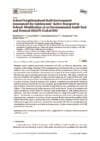Abstract
School neighbourhood built environments (SN-BE) can influence adolescents’ active transport to school habits. Typically, SN-BE assessment has involved micro-scale (i.e., environmental audits) or macro-scale (Geographic Information Systems (GIS)) assessment tools. However, existing environmental audits are time/resource-intensive and not specific to school neighbourhoods, while GIS databases are not generally purposed to include micro-scale data. This study evaluated the inter-rater reliability and feasibility of using a modified audit tool and protocol (Microscale Audit of Pedestrian Streetscapes Global–School Neighbourhood (MAPS Global-SN)) to assess the SN-BE of twelve secondary schools in Dunedin, New Zealand. Correlations between MAPS Global-SN and GIS measures of the SN-BE were also examined. Specifically, MAPS Global-SN audit and GIS spatial analysis (intersection density, residential density, land use mix, walkability) was conducted within a 0.5 km street-network buffer-zone around all twelve schools. Based on investigator and expert consultation, MAPS Global-SN included eight modifications to both auditing processes and items. Inter-rater reliability data was collected from two independent auditors across two schools. The feasibility of a condensed audit protocol (auditing one side of each street segment in the neighbourhood, compared to both sides) was also assessed. Results indicated the modified MAPS Global-SN tool had good to excellent inter-rater reliability and the condensed MAPS Global-SN audit protocol appeared to sufficiently represent the micro-scale SN-BE. Results also highlighted the complementary nature of micro- and macro-scale assessments. Further recommendations for SN-BE assessment are discussed.



Responses